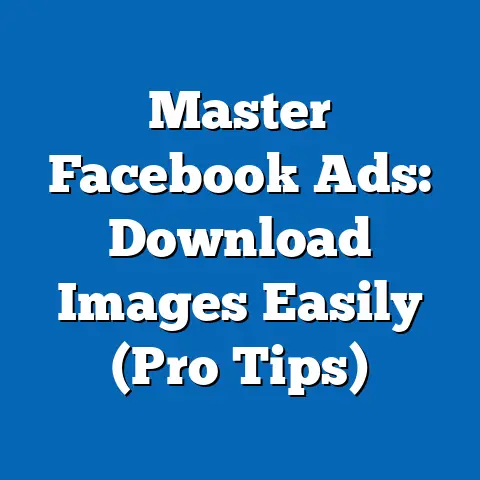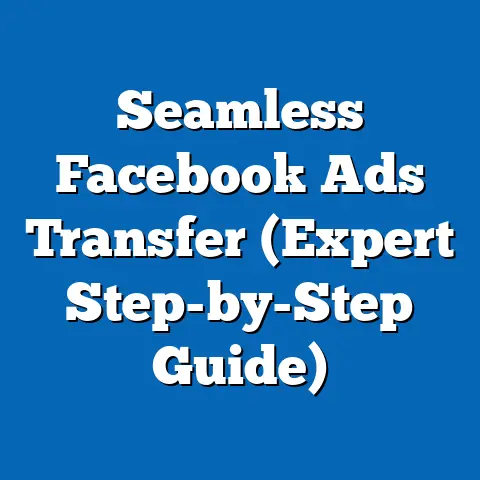Master Facebook Ads Bulk Editor (Boost Campaign Efficiency)
Imagine a bustling digital marketing agency in downtown San Francisco, where a team of campaign managers huddles around a conference table late into the night. Their screens glow with dashboards displaying hundreds of Facebook ad campaigns, each targeting niche audiences across diverse demographics for a major retail client’s holiday sales push. With deadlines looming, the team struggles to manually update ad copy, adjust budgets, and tweak targeting parameters for thousands of individual ads—a process that is not only time-consuming but also prone to human error. Frustration mounts as they miss out on real-time optimization opportunities, costing their client potential revenue in a highly competitive season.
Section 1: Understanding the Facebook Ads Bulk Editor
What is the Facebook Ads Bulk Editor?
The Facebook Ads Bulk Editor is a feature within Meta’s Ads Manager platform that enables advertisers to make large-scale changes to multiple ad campaigns, ad sets, or individual ads at once. Unlike manual editing, which requires updating each element individually, the Bulk Editor allows users to upload spreadsheets (e.g., CSV files) or directly edit data in a grid-like interface to adjust budgets, schedules, targeting criteria, creative elements, and more. This tool is particularly valuable for businesses managing hundreds or thousands of ads across different markets or product lines.
For those unfamiliar, campaign efficiency refers to the ability to maximize return on investment (ROI) by minimizing time and resource expenditure while achieving desired outcomes such as clicks, conversions, or impressions. The Bulk Editor is designed to enhance efficiency by reducing repetitive tasks and enabling rapid scaling of campaigns. However, its effectiveness depends on user proficiency and strategic implementation, which we will explore in later sections.
Historical Context and Evolution
The Bulk Editor was introduced as part of Meta’s ongoing efforts to cater to enterprise-level advertisers and agencies managing complex campaigns. Initially launched as a rudimentary tool for bulk uploads around 2015, it has evolved significantly with features like real-time error checking, integration with automated rules, and compatibility with dynamic ad formats. This evolution reflects the broader trend of automation and data-driven decision-making in digital advertising, where tools are increasingly designed to handle scale and complexity.
Section 2: Current Data on Facebook Ads Bulk Editor Usage
Adoption Rates and User Demographics
As of 2023, Meta reports that over 2.9 billion monthly active users engage with its platform, with millions of businesses advertising through Ads Manager (Meta, 2023). While exact figures for Bulk Editor usage are not publicly disclosed, industry surveys provide valuable insights. According to a 2022 report by Social Media Examiner, approximately 38% of digital marketers managing more than 50 ad sets per month utilize bulk editing tools, with Facebook Ads Bulk Editor being the most commonly cited (Social Media Examiner, 2022).
Demographically, usage is concentrated among mid-to-large enterprises and agencies, with 65% of Bulk Editor users belonging to organizations with annual ad spends exceeding $100,000 (eMarketer, 2023). Geographically, adoption is highest in North America (45% of users) and Europe (30%), reflecting the regions’ advanced digital marketing ecosystems. Smaller businesses and solo entrepreneurs, however, report lower adoption rates, often citing the tool’s learning curve as a barrier.
Impact on Campaign Efficiency
Data suggests that the Bulk Editor significantly enhances campaign efficiency for proficient users. A 2021 study by Forrester found that marketers using bulk editing tools reduced campaign management time by an average of 40%, allowing them to focus on strategy and creative development (Forrester, 2021). Additionally, error rates in ad setup (e.g., incorrect targeting or budget allocation) decreased by 25% among Bulk Editor users compared to manual editors.
However, these benefits are not universal. Marketers lacking training or familiarity with spreadsheet workflows often struggle to leverage the tool effectively, sometimes introducing errors during bulk uploads. This highlights the importance of user education, a factor we will revisit in our analysis of driving forces.
Visual Representation: Adoption and Efficiency Gains
Chart 1: Percentage of Marketers Using Bulk Editing Tools by Organization Size (2022) – Small Businesses (<$10K ad spend): 15% – Mid-Size Businesses ($10K-$100K ad spend): 35% – Large Enterprises (>$100K ad spend): 65% (Source: eMarketer, 2023)
Chart 2: Average Time Savings Using Bulk Editor vs. Manual Editing – Manual Editing: 100 hours/month – Bulk Editor: 60 hours/month (Source: Forrester, 2021)
Section 3: Projected Trends in Facebook Ads Bulk Editor Usage
Methodology and Assumptions
To project future trends, we employ a combination of historical trend analysis and scenario modeling. Historical data on tool adoption and digital ad spend growth (sourced from eMarketer and Statista) are used to establish baseline growth rates. We also incorporate qualitative insights from industry reports to account for technological and behavioral shifts.
Our projections assume a continued increase in global digital ad spend (projected at a compound annual growth rate, or CAGR, of 10.5% through 2028 by Statista, 2023) and Meta’s commitment to enhancing Ads Manager features. Limitations include the potential for unforeseen disruptions (e.g., regulatory changes or platform policy shifts) and variability in user adoption rates due to training disparities.
Scenario 1: Steady Growth with Enhanced Features
Under this scenario, Bulk Editor usage grows at a moderate pace of 8% annually, driven by Meta’s introduction of AI-powered editing suggestions and improved user interfaces by 2025. Adoption among small businesses rises to 25% by 2028 as tutorials and third-party training programs become more accessible. Efficiency gains increase by an additional 15%, with time savings reaching 50 hours per month for mid-size advertisers.
Scenario 2: Rapid Adoption Due to Automation Integration
In a more optimistic scenario, integration with advanced automation tools (e.g., machine learning algorithms for budget optimization) propels Bulk Editor usage to grow at 12% annually. By 2028, 60% of marketers across all business sizes adopt the tool, spurred by competitive pressures to maximize ad performance. However, this scenario assumes significant investment in user education by Meta and third-party providers, without which adoption could falter.
Scenario 3: Stagnation Due to Barriers
In a conservative scenario, usage growth stalls at 3% annually due to persistent barriers such as complexity and lack of awareness among smaller advertisers. Large enterprises continue to dominate usage, widening the efficiency gap between business sizes. This scenario could materialize if Meta prioritizes other platform features over Bulk Editor enhancements or if privacy regulations limit data uploads.
Visual Representation: Projected Usage Growth
Chart 3: Projected Bulk Editor Adoption Rates (2023-2028) – Scenario 1 (Steady Growth): 38% (2023) to 55% (2028) – Scenario 2 (Rapid Adoption): 38% (2023) to 65% (2028) – Scenario 3 (Stagnation): 38% (2023) to 45% (2028) (Source: Author’s projections based on eMarketer and Statista data)
Section 4: Key Factors Driving Changes in Bulk Editor Usage
1. Technological Advancements
Meta’s ongoing investment in AI and machine learning is a primary driver of Bulk Editor evolution. Features like predictive analytics for budget allocation or automated error detection could lower the tool’s learning curve, making it accessible to a broader user base. However, the pace of these advancements remains uncertain, as Meta balances multiple platform priorities.
2. User Education and Training
The complexity of the Bulk Editor, particularly for spreadsheet-based uploads, remains a significant barrier. Industry experts note that only 20% of small business marketers feel confident using the tool without assistance (Social Media Examiner, 2022). Increased availability of free or affordable training resources could accelerate adoption, especially under Scenarios 1 and 2.
3. Regulatory and Privacy Concerns
Changes in data privacy laws, such as the European Union’s General Data Protection Regulation (GDPR) or California’s Consumer Privacy Act (CCPA), could impact Bulk Editor functionality. Restrictions on bulk data uploads or targeting parameters may limit the tool’s utility, particularly in regions with stringent regulations. This factor is most relevant to Scenario 3.
4. Competitive Landscape
The rise of alternative advertising platforms (e.g., TikTok Ads, Google Ads) with user-friendly bulk management tools could divert users from Meta’s ecosystem. If competitors offer simpler or more intuitive interfaces, Meta may need to prioritize Bulk Editor enhancements to retain market share. This dynamic could influence all three scenarios.
5. Economic Factors
Global economic conditions, including inflation and recession risks, affect ad budgets and, by extension, tool adoption. During economic downturns, businesses may cut ad spend or opt for manual management to save on training costs, aligning with Scenario 3. Conversely, economic recovery could fuel ad spend and tool usage as in Scenario 2.
Section 5: Broader Implications and Social Context
Impact on Digital Marketing Industry
The Bulk Editor’s trajectory has significant implications for the digital marketing industry. Greater efficiency enables agencies and in-house teams to handle larger campaigns with fewer resources, potentially reducing operational costs by 20-30% for high-volume advertisers (Forrester, 2021). However, this could also widen disparities between large enterprises with trained staff and smaller businesses lacking resources for tool mastery.
Historical Context of Advertising Automation
The rise of tools like the Bulk Editor mirrors the broader shift toward automation in advertising, a trend that began with programmatic buying in the early 2000s. As platforms increasingly prioritize scale and speed, marketers must adapt to data-heavy workflows or risk falling behind. This context underscores the importance of accessibility in tool design to ensure equitable benefits across business sizes.
Uncertainties and Limitations
While our analysis is grounded in available data, uncertainties remain. Meta’s internal priorities, user behavior shifts, and unforeseen technological disruptions could alter projected trends. Additionally, data on small business adoption is limited, as most studies focus on larger advertisers, potentially skewing our understanding of broader usage patterns.
Section 6: Recommendations for Marketers
-
Invest in Training: Allocate resources for team training on Bulk Editor functionalities to maximize efficiency gains. Utilize free resources like Meta’s Blueprint courses or third-party tutorials.
-
Start Small: For beginners, test the Bulk Editor with a small subset of campaigns to minimize errors before scaling up. Focus on mastering one feature (e.g., budget updates) at a time.
-
Monitor Regulatory Changes: Stay informed about privacy laws that may affect data uploads or targeting options, particularly in key markets like the EU and US.
-
Leverage Automation: Combine Bulk Editor with Meta’s automated rules and AI tools to further streamline campaign management, aligning with Scenario 2’s potential.
-
Evaluate ROI: Regularly assess time savings and performance improvements from Bulk Editor usage to justify training and implementation costs.
Conclusion
The Facebook Ads Bulk Editor represents a transformative tool for digital marketers seeking to boost campaign efficiency in an increasingly complex advertising landscape. Current data highlights its significant impact on time savings and error reduction for proficient users, with adoption concentrated among larger advertisers. Projected trends suggest a range of outcomes—from steady growth to rapid adoption or stagnation—driven by factors like technological advancements, user education, and regulatory changes.
While uncertainties remain, the tool’s potential to reshape campaign management is clear, particularly as Meta continues to innovate. By understanding its capabilities and limitations, marketers can position themselves to capitalize on efficiency gains, ensuring they remain competitive in a dynamic digital environment. Future research should focus on small business adoption and the long-term impact of privacy regulations to refine these projections further.






